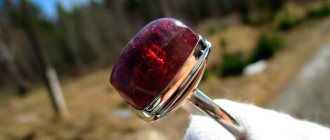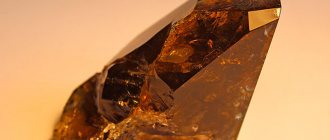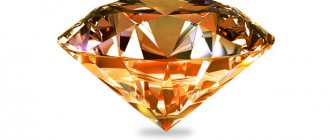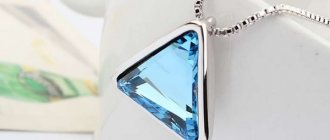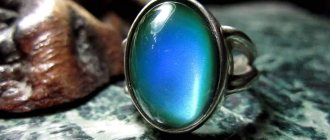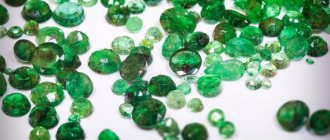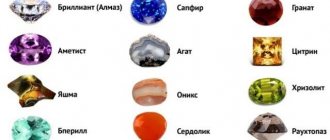A stone that changes color is mysterious and attractive. It suits the same changeable natures, which coincide with the mineral in energy and change with it. This is the mineral of flexible and free people who are ready to experiment and have a subtle sensitive nature. Such minerals are also called alexandrite effect stones, after the name of the most famous stone - the chameleon. They are united by one common property - these are precious, semi-precious stones with crystal transparency.
Chameleon stones and their properties
Stones that change color have three varieties:
- Stones with alexandrite effect or reverse effect. Change depending on lighting and other influences.
- Stones with pleochroism. Change color depending on the observation point.
- Dichroism. Slight color variation in two shades.
The most beautiful and mysterious stones are chameleons, with a reverse spectrum:
- Amethyst. A type of quartz. Depending on the deposit, it comes in different colors - from lavender to deep purple. Lavender amethyst turns pale when exposed to bright light or heat. As air humidity increases, the stone darkens. Can serve as a weather indicator - indicate the approach of thunderstorms and rain. Dark amethyst is good in daylight, in the evening it fades and ceases to show deep color shades.
- Alexandrite, the royal gem. It has a deep, multi-faceted color. The stone changes along with the light rays. Ultraviolet gives the mineral olive and emerald shades. Evening lighting darkens the stone and gives it dark purple and even violet colors. At dusk, the mineral flashes with scarlet highlights and can become the color of ripe raspberries.
Alexandrite
Real alexandrites are mined in Africa, Brazil and India. They are rare and expensive. Brazilian alexandrite varies in color from pink to sea green. African color changes from yellow-pink to green. Indian is closer in color to Brazilian, but much lighter.
- Aquamarine, a type of beryl. The color spectrum depends on the lighting. A unique mysterious stone, its color is fluid like water. The mineral shimmers from milky blue to green, flashing from the depths with golden sparks. In bright light the stone becomes almost transparent. Changing light throughout the day transforms the stone, causing it to play with different colors.
- Garnet is a pyrope. During the day, the stone plays with shades of green and purple. With the onset of dusk it becomes wine-red, by night it becomes almost black with cognac sparkles.
- Sultanite. By nature it is endowed with mysterious tints of yellow, emerald, pink and purple. It changes with the lighting. In bright sun it turns cognac yellow, and at dusk it darkens to purple. Under artificial light it will turn green. This is a rather rare stone, which is now mined in Turkey. The natural mineral has a green base color.
- Corundum. It includes sapphires and rubies. They change when heated, becoming brighter and darker. African blue sapphire can react to artificial light by appearing purple.
- Tourmaline. It comes in pink, green, emerald and yellow. If it is pink during the day, it turns brown in the evening. Green tourmaline will turn red in artificial light. Reacts to high temperatures. This property is used by jewelers who transform the natural color into a deeper one.
- Iolite A semi-precious mineral that changes shades in one color spectrum: from violet to bright blue.
- Topaz is a weak chameleon. It brightens greatly in bright light, becoming almost transparent.
- Citrine changes in the yellow spectrum. Can be lemon and orange.
- Ametrine is a plechroic stone, but also reacts to light. This is a light pink-green crystal. Under the bright sun it becomes light and loses its shades.
- Blue apatite has a strong alexandrite effect. Under artificial light it turns yellow-green.
- Chrome diopside is capable of turning from yellow to green.
- Tanzanite reacts to light by changing its color from blue to brownish green.
- Zircon changes color when heated. Yellow stones take on different shades of blue. Heliodor has the same property.
- Blue spinel has an alexandrite effect. Under artificial light it turns purple.
- Fire opal is colored in bright red-orange and bluish-yellow colors. Opals from Mexican deposits have iridescent highlights.
Tourmaline
Opal reacts to changes in humidity. A blue stone turns orange in the rain, and a red stone turns yellow. If the air simply becomes more humid, the color change will be less intense.
Varieties of gems
Varieties of gems
Most girls do not know the stones from which jewelry is made. But this information is important. There are 5 thousand minerals in nature. Many precious stones are used for jewelry. There are many different classifications of gems. One of the most popular is A.E. Fersman. According to it, gems are divided into three groups, in each of which subgroups (orders) are often distinguished.
Classification and name of stones:
- Precious. Rare and therefore the most expensive minerals, they are also the hardest and most durable. The highest (first) order includes sapphire, diamond, of all shades, emerald, ruby, as well as chrysoberyl, alexandrite. Gems of ideal purity and transparency, without foreign elements, cracks, and large sizes are most valued. This group sometimes includes zircon and some types of topaz.
- Semi-precious. They cost less, so they are widespread. However, the most unique representatives can be classified as precious stones. This category includes minerals such as opal, tourmaline, and chrysolite. Usually amethyst is also included in this group.
- Ornamental. The most beautiful specimens can be quite expensive. This category often includes jasper, turquoise, as well as rock crystal, quartz, and malachite with intricate patterns. The list of ornamental stones is complemented by vesuvian, sodalite, and the mysterious tiger and cat's eye. Typically, ornamental gems are represented by opaque minerals.
Photos and names of some stones that are used to create jewelry
Many precious stones that are found in the environment have been grown artificially. But natural gems are valued more highly because they can change a person’s mood and improve health.
To make a gem look beautiful, it is cut and polished.
The color of the stones and the mood of the owner
The pomegranate reacts to the owner’s mood. It is a kind of indicator of the owner’s energy. The stone patronizes strong and integral natures that have positive energy. He plays with them with red rays. When a person is tired, weak or sick, the garnet becomes dull. He helps the owner, taking the negativity onto himself.
Aquamarine also senses human energy. If he feels angry, the stone becomes cloudy. It fades if it feels sad and depressed.
Chameleons cannot harm their owner. They strive to help, adapting to the needs of the owner. Playing with green flowers, they try to calm a person and give him vitality. Going into the red spectrum, the stones set you up for passion and activity, helping to attract the opposite sex.
Aquamarine
It is no coincidence that in the evening the color of the stones becomes deeper, tuning in to sensual experiences.
Cost of gems
Prices for precious gems depend on many factors. Not only the physicochemical properties and appearance are important, but also the rarity of its occurrence in nature. For example, the cost of 1 carat of a high-quality diamond is 18-18 thousand dollars, but the price per carat of its dark red variety reaches 1 million dollars.
The region of origin also matters. Some of the highest quality and purest minerals are mined in Russia (in Yakutia and the Urals). Also leading are the countries of Africa and Australia, where placers and deposits of rare varieties of gems, such as red emeralds, are often found.
Who is suitable for volatile minerals?
If we talk about compatibility by zodiac signs, then alexandrite is suitable for the water element. Flowing water itself likes to change its color, and the mineral suits these signs in terms of energy. Opal has similar compatibility with water signs.
Amethyst helps Libra, Aquarius and Gemini. Does not coincide with the energies of Taurus and Leo.
Chameleons are suitable for water and air signs. They are not calm by nature, just like a chameleon can change their mood during the day.
For earth signs, chameleons can serve as agents for change. These signs are too rigid, so stones that change color will promote flexibility.
Esotericists believe that volatile minerals help to collect missing energy or remove excess energy. The stone senses what the owner lacks and corrects it.
Gemstone concept. Features of terminology
There is currently no general definition of the concept of “precious mineral” in the world. In most cases, this group includes stones that meet 3 requirements:
- beauty of appearance;
- uniqueness;
- strength.
In the first case, gloss, play of light, shimmer and optical properties such as dispersion and pleochroism are assessed. The difficulty of finding such minerals or their minimal content in rocks causes a “scarcity”, making the gems more unique and thus ensuring a growing demand.
Durability is directly related to the strength, hardness and density of the gemstone. All these factors have a great influence on the formation of the market value of the gem.
If we talk about the legal side, then according to Russian laws the following are classified as precious materials:
- diamonds;
- rubies;
- emeralds;
- natural alexandrites;
- sapphires;
- unique amber formations;
- natural sea pearls.
Evaluation criteria for any characteristics are not specified. Most likely, the selection was made on the basis of a list of in-demand precious materials, whose circulation the state seeks to control.
Interesting! Unofficially, there are several classifications of precious stones. Each country decides which estimation method to use and how to make the breakdown.
How to care for chameleon stones?
Minerals can lose their luster if not cared for. To restore brightness, you need to periodically do the following:
- Wash the jewelry or stone in warm soapy water. Do not use washing powder. The frame should be cleaned with a toothbrush to remove dirt.
- You can polish the mineral with a piece of suede or flannel.
Chameleons must be stored correctly and the operating rules must be followed:
- Each gem must be stored in individual packaging. If there is no box, a bag made of natural fabric will do.
- Stones should be protected from bright sun and high temperatures. You cannot wear them in the sauna, place them in direct sunlight, or sunbathe in them on the beach.
- The use of cosmetic creams and perfumes is incompatible with the presence of jewelry. Skin care and perfume application should be done while the jewelry is not yet worn.
- When using a hairdryer, high temperatures can have a negative effect on the earrings. It is better to remove them for a while.
- Before cleaning, jewelry must be removed.
- Do not drop stones or expose them to chemicals.
Chameleon stones are capable of changing themselves and changing their owner. You can coincide with them or not share their energy. You can understand this only by trying to carry a stone.
You can believe in esoteric properties or simply admire the transformations in the color of crystals. In any case, wearing a stone that changes color will bring pleasure to its owner.
Shine
In the description of precious stones, in addition to physical properties and chemical composition, there is such a characteristic as shine. This effect is a consequence of the refraction of light from the surface of the mineral, independent of its shade.
The degree of surface treatment of the crystal matters. Light is reflected better from a smooth plane than from a rough one. In the latter case, it most often dissipates, so the correct cut of the stone is very important to enhance this characteristic.
The following types of gloss are distinguished:
- metal;
- diamond;
- glass;
- resin;
- wax;
- fatty;
- pearl.
The most valuable minerals, diamonds, have a diamond-like luster.
View this post on Instagram
What, what, what, what... are jewelry made from?
